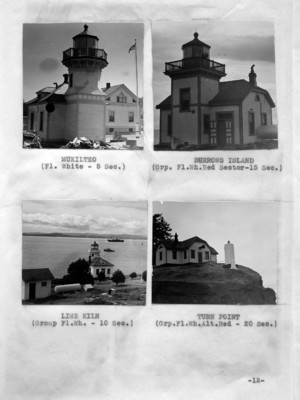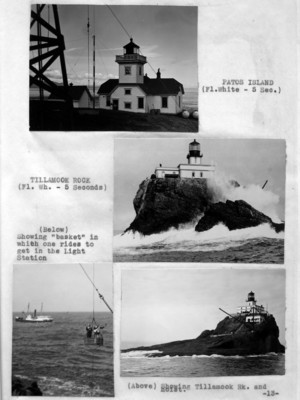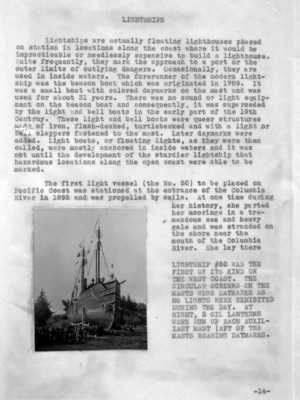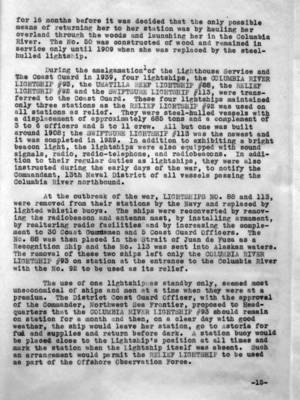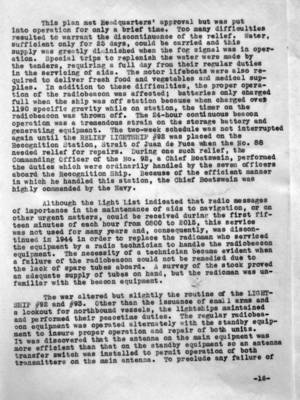Pages
31
(Image top left)
MUKILTEO (Fl. White - 5 Sec.)
(Image top right)
BURROWS ISLAND (Grp. Fl.Wh.Red Sector-15 Sec.)
(Image bottom left)
LIME KILN (Group Fl.Wh. - 10 Sec.)
(Image bottom right)
TURN POINT (Grp.Fl.Wh.Alt.Red - 20 Sec.)
32
(Image top)
PATOS ISLAND (Fl.White - 5 Sec.)
(Image middle)
TILLAMOOK ROCK (Fl. Wh. - 5 Seconds)
(Below) Showing "basket" in which one rides to get in the Light Station
(Image bottom left)
(Image bottom right)
(Above) Showing Tillamook Rk. and hoist.
33
Lightships are actually floating lighthouses placed on station in locations along the coast where it would be impracticable or needlessly expensive to build a lighthouse. Quite frequently, they mark the approach to a port or the outer limits of outlying dangers. The forerunner of the modern lightship was the beacon boat which was originated in 1789. It was a small boat with colored daymarks on the mast and was used for about 31 years. There was no sound or light equipment on the beacon boat and consequently, it was superseded by the light and bell boats in the early part of the 19th Century. These light and bell boats were queer structures made of iron, flash-decked, turtlebacked and with a light or bell clappers fastened to the mast. Later daymarks were added. Light boats, or floating lights, as they were then called, were mostly anchored in inside waters and it was not until the development of the sturdier lightship that hazardous locations along the open coast were able to be marked.
The first light vessel (the No. 50) to be placed on Pacific Coast was stationed at the entrance of the Columbia River in 1892 and was propelled by sails. At one time during her history, she parted her moorings in a tremendous sea and heavy gale and was stranded on the shore near the mouth of the Columbia River. She lay there
(Image bottom left)
LIGHTSHIP #50 WAS THE FIRST OF ITS KIND ON THE WEST COAST. THE CIRCULAR SCREENS ON THE MASTS WERE DAYMARKS AS NO LIGHTS WERE EXHIBITED DURING THE DAY. AT NIGHT, 3 OIL LANTERNS WERE RUN UP EACH AUXILIARY MAST (AFT OF THE MASTS BEARING DAYMARKS.
34
for 16 months before it was decided that the only possible means of returning her to her station was by hauling her overland through the woods and launching her in the Columbia River. The No. 50 was constructed of wood and remained in service only until 1909 when she was replaced by the steel-hulled lightship.
During the amalgamation of the Lighthouse Service and The Coast Guard in 1939, four lightships, the COLUMBIA RIVER LIGHTSHIP 393, the UMATILLA REEF LIGHTSHIP #88, the RELIEF LIGHTSHIP #92 and the SWIFTSURE LIGHTSHIP #113, were transferred to the Coast Guard. These four lightships maintained only three stations as the RELIEF LIGHTSHIP #92 was used on all stations as relief. They were steel-hulled vessels with a displacement of approximately 685 tones and a complement of 3 to 6 officers and 5 to 11 crew. All but one was built around 1908; the SWIFTSURE LIGHTSHIP #113 was the newest and it was completed in 1929. In addition to exhibiting a bright beacon light, the lightships were also equipped with sound signals, [radio]], radio-telephone, and radiobeacons. In addition to their regular duties as lightships, they were also instructed during the early days of the war, to notify the Commandant, 13th Naval District of all vessels passing the Columbia River northbound.
At the outbreak of the war, LIGHTSHIPS NO. 88 and 113, were removed from their stations by the Navy and replaced by lighted whistle buoys. The ships were reconverted by removing the radiobeacon and antenna mast, by installing armament, by realtering radio facilities and by increasing the complement to 30 Coast Guardsmen and 5 Coast Guard Officers. The No. 88 was then placed in the Strait of Juan de Fuca as a Recognition Ship and the No 113 was sent into Alaskan waters. The removal of these two ships left only the COLUMBIA RIVER LIGHTSHIP #93 on station at the entrance to the Columbia River with the No. 92 to be used as its relief.
The use of one lightship as standby only, seemed most uneconomical of ships and men at a time when they were at a premium. The District Coast Guard Officer, with the approval of the Commander, Northwest Sea Frontier, proposed to Headquarters that the COLUMBIA RIVER LIGHTSHIP #93 should remain on station for a month and then, on a clear day with good weather, the ship would leave her station, go to Astoria for fuel and supplies and return before dark. A station buoy would be placed close to the Lightship's position at all times and mark the station when the Lightship itself was absent. Such an arrangement would permit the RELIEF LIGHTSHIP to be used as part of the Offshore Observation Force.
35
This plan met Headquarters' approval but was put into operation for only a brief time. Too many difficulties resulted to warrant the discontinuance of the relief. Water, sufficient only for 25 days, could be carried and this supply was greatly diminished when the fog signal was in operation. Special trips to replenish the water were made by the tenders, requiring a full day from their regular duties in the servicing of aids. The motor lifeboats were also required to deliver fresh food and vegetables and medical supplies. In addition to these difficulties, the proper operation of the radiobeacon was affected; batteries only charged full when the ship was off station because when charged over 1190 specific gravity while on station, the timer on the radiobeacon was thrown off. The 24-hour continuous beacon operation was a tremendous strain on the storage battery and generating equipment. The two-week schedule was not interrupted again until the RELIEF LIGHTSHIP #92 was placed on the Recognition Station, Strait of Juan de Fuca when the No. 88 needed relief for repairs. During one such relief, the Commanding Officer of the No. 92, a Chief Boatswain, performed the duties which were ordinarily handled by the seven officers aboard the Recognition Ship. Because of the efficient manner in which he handled this station, the Chief Boatswain was highly commended by the Navy.
Although the Light List indicated that radio messages of importance in the maintenance of aids to navigation, or on other urgent matters, could be received during the first fifteen minutes of each hour from 0800 to 2015, this service was not used for many years and, consequently, was discontinued in 1944 in order to replace the radioman who serviced the equipment by a radio technician to handle the radiobeacon equipment. The necessity of a technician became evident when a failure of the radiobeacon could not be remedied due to the lack of spare tubes aboard. A survey of the stock proved an adequate supply of tubes on hand, but the radioman was unfamiliar with the beacon equipment.
The war altered but slightly the routine of the LIGHTSHIP #92 and #93. Other than the issuance of small arms and a lookout for the northbound vessels, the lightships maintained and performed their peacetime duties. The regular radiobeacon equipment was operated alternately with the standby equipment to insure proper operation and repair on both units. It was discovered that the antenna on the main equipment was more efficient than that on the standby equipment so an antenna transfer switch was installed to permit operation of both transmitters on the main antenna. To preclude any failure of
